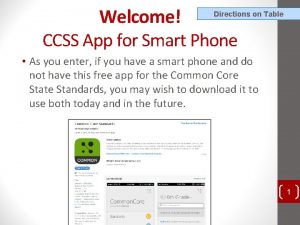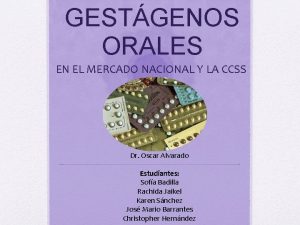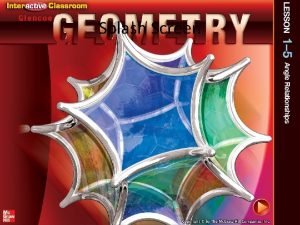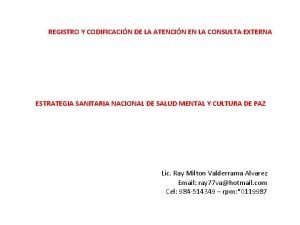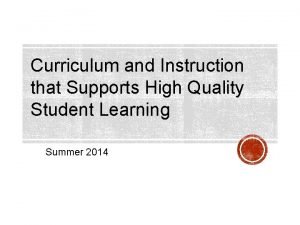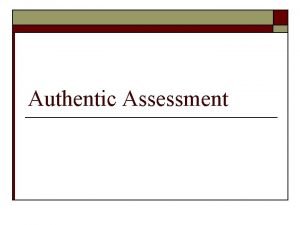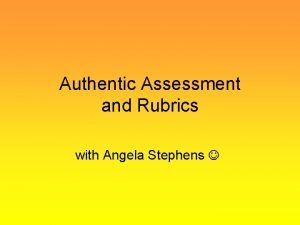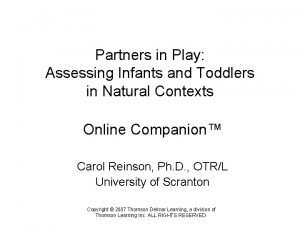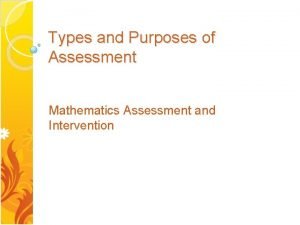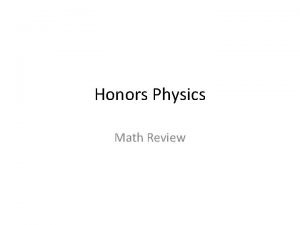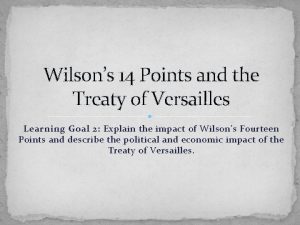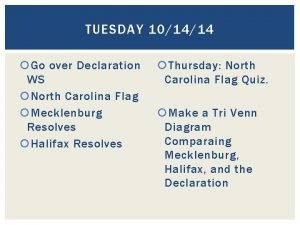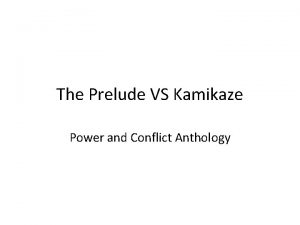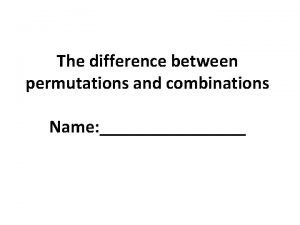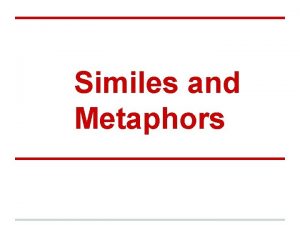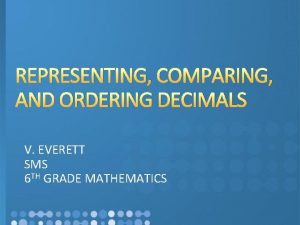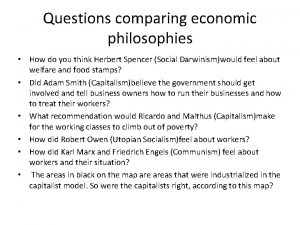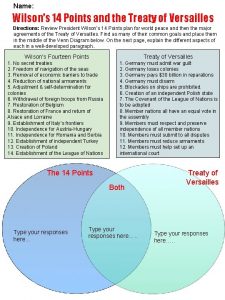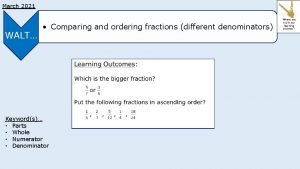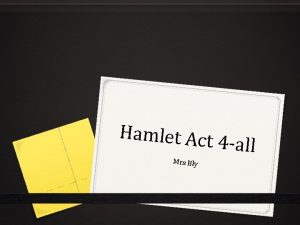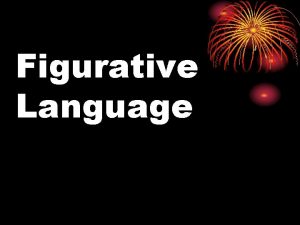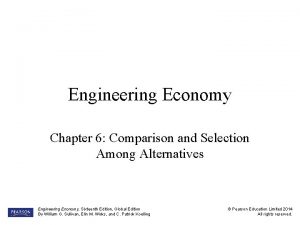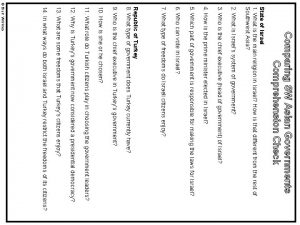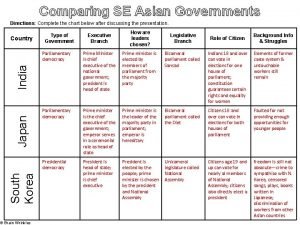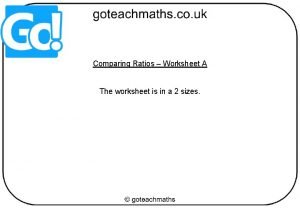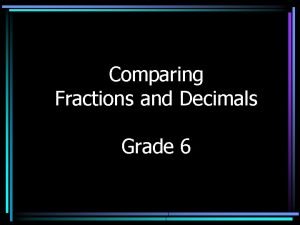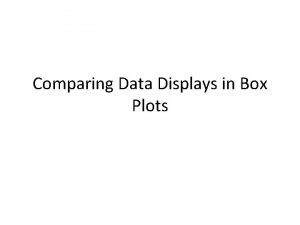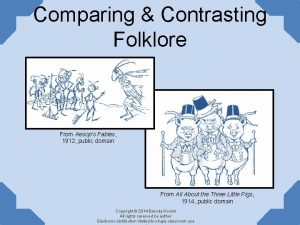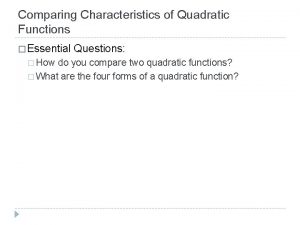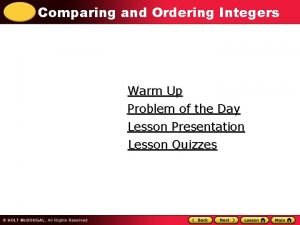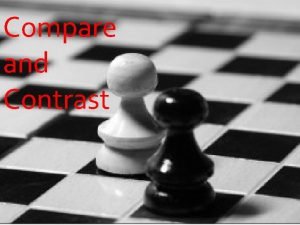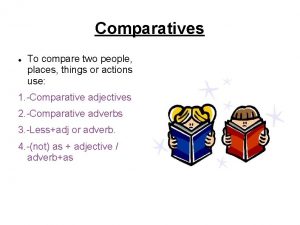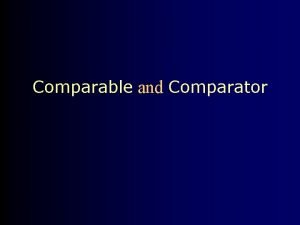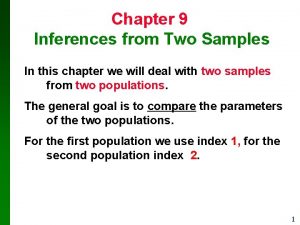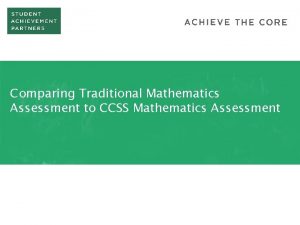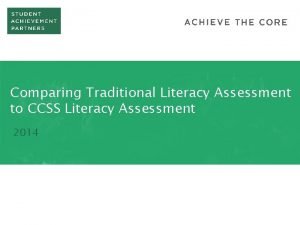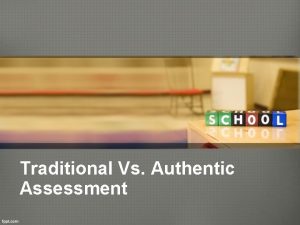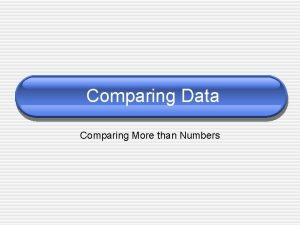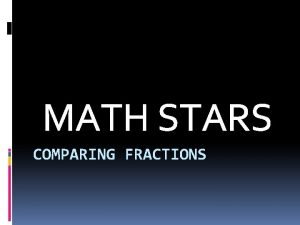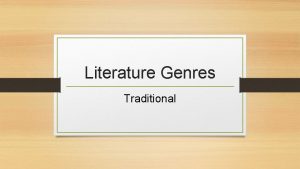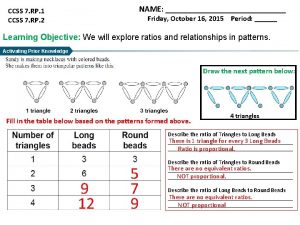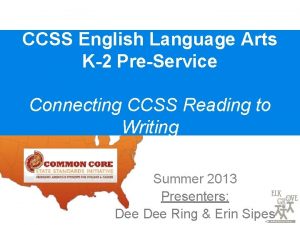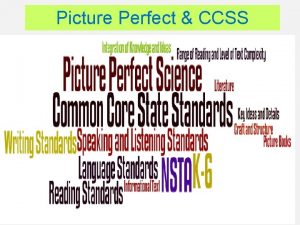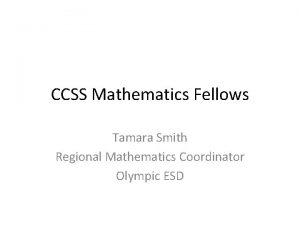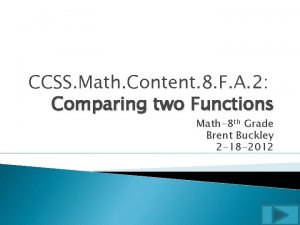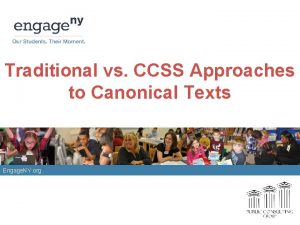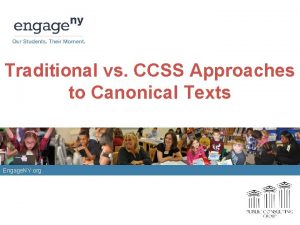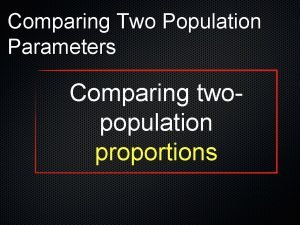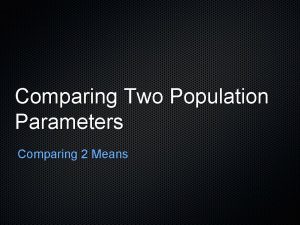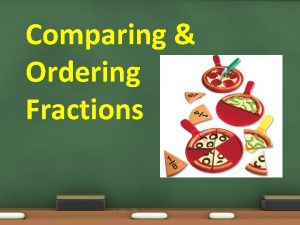Comparing Traditional Mathematics Assessment to CCSS Mathematics Assessment












































- Slides: 44

Comparing Traditional Mathematics Assessment to CCSS Mathematics Assessment

Outline of the Presentation Topic Slides The Shifts: An Overview 3– 8 Making the Shifts in Assessment • Focus 9– 19 • Coherence 20– 28 • Rigor 29– 38 Summary and Resources 39– 44 PAGE 2

The Shifts: An Overview

How Are The Standards Different? An Overview of the Shifts The CCSS bring three key shifts to mathematics instruction and assessment. 1. Focus strongly where the standards focus* 2. Coherence: think across grades, and link to major topics within grades 3. Rigor: in major topics* pursue: • conceptual understanding, • procedural skill and fluency, and • application with equal intensity. *For a list of major, supporting, and additional clusters by grade, please refer to ‘Where to focus by grade level” at http: //achievethecore. org/shifts-mathematics PAGE 4

How Are CCSS Assessments Different? An Overview Shift 1: Focus strongly where the Standards focus From To Cover content that is a “milewide and an inch-deep” Assess fewer topics at each grade (as required by the Standards) Give equal importance to all content Dedicate large majority of score points to the major work* of the grade PAGE 5

How Are CCSS Assessments Different? An Overview Shift 2: Coherence: think across grades, and link to major topics within grades From To Assessment as a checklist of individual standards Items that connect standards, clusters, and domains (as is natural in mathematics) as well as items that assess individual standards Each topic in each year is treated as an independent event Consistent representations are used for mathematics across the grades, and Content connects to and builds on previous knowledge PAGE 6

How Are CCSS Assessments Different? An Overview Shift 3: Rigor: in major topics pursue conceptual understanding, procedural skill and fluency, and application with equal intensity From To Unbalanced emphasis on procedure or application Assessment of all three aspects of rigor in balance A lack of items that require conceptual understanding Items that require students to demonstrate conceptual understanding of the mathematics, not just the procedures Fluency items that are only routine and ordinary Fluency items that are presented in new ways, as well as some that are routine and ordinary Application of mathematics to routine and contrived word problems Application of mathematics to authentic non-routine problems and real-world situations PAGE 7

For More Information on the Shifts For more information on the Shifts, please see the newly updated Introduction to the Math Shifts Professional Development Module on achievethecore. org. PAGE 8

Making the Shifts in Assessment: Assessments focus where the standards focus

Focus in K– 8 PAGE 10

Focus in K– 8 Major Work of the Grade The large majority of score points on any grade-level assessment system should be devoted to the major work of the grade. See achievethecore. org/focus for major work at other grade levels. PAGE 11

Focus in K– 8 Distribution of Score Points Traditional Summative Assessment (Grade 6) % of Domain Points Ratios and Proportional 20 Relationships The Number System 20 Expressions and 20 Equations CCSS-Aligned Summative Assessment (Grade 6) Domain (with Clusters) % of Pts Ratios and Proportional Relationships (6. RP. A: 18 pts) 18 The Number System 27 Expressions and Equations 38 (6. NS. A: 12 pts, 6. NS. B: 7 pts, 6. NS. C: 10 pts) (6. EE. A: 13 pts, 6. EE. B: 15 pts, 6. EE. C: 10 pts) Geometry 20 Geometry (6. G. A: 7 pts) 7 Statistics and Probability 20 Statistics and Probability 8 Total 100 % on Major Work 53 (6. SP. A: 4 pts, 6. SP. B: 4 pts) Total *Green denotes Major Clusters % on Major Work 100 78 Source: Student Achievement Partners. For illustrative purposes only. PAGE 12

Focus in K– 8 Grade 2 Geometry Example Traditional Approach (Grade 2 Geometry) Shawn cut a rectangle along two lines of symmetry. How many equal shares will he have? CCSS-Aligned Approach (2. G. A. 3) Ms. Nim gave her students a picture of a rectangle. Then she asked them to shade in one half of the rectangle. Here are three pictures: Which ones show one half? Explain. Source: Illustrative Mathematics. https: //www. illustrativemathematics. org/illustrations /827 PAGE 13

Focus in K– 8 Measures of Center Example Traditional Approach (Grade 3 Mean and Median) CCSS-Aligned Approach (6. SP. B. 4, 5 c)) Source: Illustrative Mathematics. https: //www. illustrativemathematics. org/illustration s/877 PAGE 14

Focus in K– 8 Supporting Work Reinforcing Major Work Traditional Approach (Grade 1) CCSS-Aligned Approach (1. MD. C. 4) PAGE 15

Focus in K– 8 Supporting Work Reinforcing Major Work Traditional Approach (Grade 7) CCSS-Aligned Approach (7. SP. C. 8) A coin is flipped three times. Part A: Draw a tree diagram that shows all possible outcomes. Part B: Create an organized list that shows all possible outcomes. HHH HHT HTH HTT THH THT TTH TTT 2 Source: Engage. NY. http: //www. engageny. org/sites/default/files/resource/attac hments/math-grade-7. pdf PAGE 16

Focus in High School Widely Applicable Prerequisites for College and Careers www. achievethecore. org/prerequisites PAGE 17

Focus in High School Widely Applicable Prerequisites Traditional Approach (Geometry) CCSS-Aligned Approach (G-CO. C. 10, G-SRT. C) In the diagram below of rhombus PQRS, decide whethere is enough information to prove that the two triangles are congruent. Source: Illustrative Mathematics. https: //www. illustrativemathematics. org/illustratio ns/1322 PAGE 18

Focus in High School The mile-wide inch-deep problem looks different in high school. In earlier grades it’s a matter of having too many topics. In high school it’s a matter of having too many separately memorized techniques, with no overall understanding of the structure to tie them altogether. So narrowing and deepening the curriculum is not so much a matter of eliminating topics, as seeing the structure that ties them together. –Prof. William Mc. Callum http: //commoncoretools. me/2012/02/16/the-structure-is-the-standards/#comments PAGE 19

Making the Shifts in Assessment: Assessments honor the coherence of the standards

Coherence Across Grades Seeing the Structure “The Standards were not so much assembled out of topics as woven out of progressions. ” What It Means • Aligning items to grade-level expectations requires understanding of all the standards at that grade (e. g. , NBT standards often give bounds for OA items) and understanding how the standard fits into a progression with previous and future grades Why It Matters for Assessment • The Standards were woven out of connected topics (the progressions) and so assessments should also rely on the connections between topics (coherence across grades). PAGE 21

Coherence Across Grades Consistent Progressions Traditional Progressions (Perimeter and Area) Grade 3: Grade 4: Grade 5: Grade 6: Write the area of the shape. Determine the area of the shape in square units. Find the perimeter of the figure. Select the rectangle with an area of 24 square units and a perimeter of 20 units. PAGE 22

Coherence Across Grades Consistent Progressions CCSS-Aligned Progressions (Area and Surface Area) 3. MD. C. 6: 4. MD. A. 3: 5. NF. B. 4 b: 6. G. A, 6. RP. A. 3: Find the area of each colored figure. Karl’s rectangular vegetable garden is 20 feet by 45 feet, and Makenna’s is 25 feet by 40 feet. Whose garden is larger in area? How much larger is that garden? An aerial photo of farmland shows the dimensions of a field in fractions of a mile. Create a model to show the area, in square miles, of a field that is 3/4 mile by 1/3 mile. Alexis needs to paint the four exterior walls of a large rectangular barn. The length of the barn is 80 feet, the width is 50 feet, and the height is 30 feet. The paint costs $28 per gallon, and each gallon covers 420 square feet. How much will it cost Alexis to paint the barn? Explain your work. PAGE 23

Coherence Across Grades Consistent Representations CCSS-Aligned Items Showing Coherent Representations 3. OA. B. Understand properties of multiplication and the relationship between multiplication and division. 5. Apply properties of operations as strategies to multiply and divide. 6. Understand division as an unknown-factor problem. Item: Rewrite 48 ÷ �� = 6 two ways. Source: Student Achievement Partners. For illustrative purposes only. PAGE 24

Coherence Within a Single Grade Assessing all levels of the content hierarchy Where appropriate, CCSSM items will assess content at all levels of the content hierarchy: Cluster • Part(s) of standards (5. NBT. A) • Individual standards • Multiple standards • Clusters Standards • Domains • Grade Domain This means that rather than an assessment being only a checklist of items for each individual standard, they address content in ways that connect ideas together meaningfully. PAGE 25

Coherence Within a Single Grade Assessing at the Cluster Level CCSS-Aligned Item at the Cluster Level (5. NBT. A: Understand the place value system) Are these equivalent to 9. 52? Source: Illustrative Mathematics. https: //www. illustrativemathematics. org/illustrations/1813 PAGE 26

Coherence Within a Single Grade Assessing at the Domain Level CCSS-Aligned Item at the Domain Level (5. NBT) Elmer’s Multiplication Error This is Elmer’s work on a multiplication problem: a. Use estimation to explain why Elmer’s answer is not reasonable. b. What error do you think Elmer made? c. Find 179 × 64 using a correct version of Elmer’s method. Then show another way of doing it to help Elmer see why your answer is correct. Source: Adapted from Illustrative Mathematics. https: //www. illustrativemathematics. org/illustrations/1812 PAGE 27

Coherence Within a Single Grade Assessing at the Grade Level CCSS-Aligned Item at the Grade Level (Grade 5) Minutes and Days What time was it 2011 minutes after the beginning of January 1, 2011? Source: Illustrative Mathematics. https: //www. illustrativemathematics. org/illustrations/878 PAGE 28

Making the Shifts in Assessment: Assessments reflect the rigor of the standards

Rigor Balanced Assessments CCSSM-aligned assessments and sets of assessments will be balanced by distributing score points across the three aspects of rigor: Conceptual understanding Procedural skill and fluency Application PAGE 30

Rigor Balanced Assessments The language of the Standards indicates which aspect(s) of rigor is targeted. For example, • • • Conceptual understanding 8. F. A. 1: Understand that a function is a rule that assigns to each input exactly one output. The graph of a function is the set of ordered pairs consisting of an input and the corresponding output. Procedural skill and fluency 5. NBT. B. 5: Fluently multiply multi-digit whole numbers using the standard algorithm. Application 2. MD. B. 5: Use addition and subtraction within 100 to solve word problems involving lengths that are given in the same units, e. g. , by using drawings (such as drawings of rulers) and equations with a symbol for the unknown number to represent the problem. PAGE 31

Rigor Assessing Conceptual Understanding Traditional Approach to Conceptual Understanding (Grade 2) CCSS-Aligned Approach to Conceptual Understanding (2. NBT. A) Source: Achieve the Core. http: //achievethecore. org/page/253/thinking-about-place-value-in-grade-2 PAGE 32

Rigor Assessing Conceptual Understanding Traditional Approach to Conceptual Understanding (Grade 6) CCSS-Aligned Approach to Conceptual Understanding (6. EE. A) PAGE 33

Rigor Assessing Procedural Skill and Fluency Traditional Approach to Procedural Skill and Fluency (Grade 3) CCSS-Aligned Approach to Procedural Skill and Fluency (3. OA. C. 7) Source Achieve the Core: http: //achievethecore. org/page/861/multiplicatio n-and-division-within-100 PAGE 34

Rigor Assessing Procedural Skill and Fluency Traditional Approach to Procedural Skill and Fluency (Algebra I or II) CCSS-Aligned Approach to Procedural Skill and Fluency (A-REI. B. 4) PAGE 35

Rigor Assessing Application Traditional Approach to Application (Grade 2) CCSS-Aligned Approach to Application (2. OA. A. 1) Source: Achieve the Core. http: //achievethecore. org/page/258/representing-and-solvingaddition-and-subtraction-problems-mini-assessment-detail-pg PAGE 36

Rigor Assessing Application Traditional Approach to Application (Algebra I or II) CCSS-Aligned Approach to Application (F-LE. A. 1, 2) Use the general exponential decay formula: A(t)=A 0(1–r)t to find the value of $50 after 5 years with a 25% rate of decrease per year. Source: Illustrative Mathematics. https: //www. illustrativemathematics. org/illustrations/1 306 PAGE 37

Rigor Not Always Together, Not Always Separate Traditional Approach Ignoring Combined Rigor (Algebra I) CCSS-Aligned Approach to Combining Aspects of Rigor (A-REI. B. 4, A. CED. A. 1) Source: Achievethecore. org. http: //achievethecore. org/page/976/quadraticequations-mini-assessment PAGE 38

Summary and Resources

How Are CCSS Assessments Different? An Overview Shift 1: Focus strongly where the Standards focus From To Cover content that is a “milewide and an inch-deep” Assess fewer topics at each grade (as required by the Standards) Give equal importance to all content Dedicate large majority of score points to the major work of the grade PAGE 40

How Are CCSS Assessments Different? An Overview Shift 2: Coherence: think across grades, and link to major topics within grades From To Assessment as a checklist of individual standards Items that connect standards, clusters, and domains (as is natural in mathematics) as well as items that assess individual standards Each topic in each year is treated as an independent event Consistent representations are used for mathematics across the grades, and Content connects to and builds on previous knowledge PAGE 41

How Are CCSS Assessments Different? An Overview Shift 3: Rigor: in major topics pursue conceptual understanding, procedural skill and fluency, and application with equal intensity From To Unbalanced emphasis on procedure or application Assessment of all three aspects of rigor in balance A lack of items that require conceptual understanding Items that require students to demonstrate conceptual understanding of the mathematics, not just the procedures Fluency items that are only routine and ordinary Fluency items that are presented in new ways, as well as some that are routine and ordinary Application of mathematics to routine and contrived word problems Application of mathematics to authentic non-routine problems and real-world situations PAGE 42

Additional Resources: 1. For a growing bank of mini-assessments that can be used in the classroom, go to www. achievethecore. org/math/mini-assessments. 2. For a growing bank of tasks that can be used for instructional or assessment purposes, go to www. achievethecore. org/math/tasks. 3. For more information about the Shifts, go to http: //achievethecore. org/shifts-mathematics 4. For Illustrative Math tasks, go to www. illustrativemath. org. 5. For PARCC sample items and practice tests, grades 3– 11, go to www. parcconline. org. 6. For SBAC practice tests, grades 3–high school, go to www. smarterbalanced. org. 7. For more about the progressions documents, go to http: //math. arizona. edu/~ime/progressions/#products PAGE 43

Thank you for taking the time to learn more about CCSS-aligned assessments!
 Ccss app
Ccss app Medroxiprogesterina
Medroxiprogesterina Organigrama ccss
Organigrama ccss Gerencia de pensiones
Gerencia de pensiones Ccss splash
Ccss splash Test de tamizaje para adolescentes de la ccss
Test de tamizaje para adolescentes de la ccss Jpams ccss
Jpams ccss Authentic assessments definition
Authentic assessments definition Authentic assessment rubrics
Authentic assessment rubrics Advantages of traditional assessment
Advantages of traditional assessment Types of assessment in mathematics
Types of assessment in mathematics Physics math review
Physics math review Treaty of versailles vs wilson's 14 points
Treaty of versailles vs wilson's 14 points Comparing declarations venn diagram
Comparing declarations venn diagram Comparing kamikaze and the prelude
Comparing kamikaze and the prelude Difference between permutation and combination
Difference between permutation and combination Similes examples
Similes examples Two figures of speech that involve comparison are
Two figures of speech that involve comparison are Representing comparing and ordering decimals
Representing comparing and ordering decimals Comparing economic philosophies worksheet answers
Comparing economic philosophies worksheet answers Comparing the 14 points & treaty of versailles paragraph
Comparing the 14 points & treaty of versailles paragraph Concept map comparing mitosis and meiosis
Concept map comparing mitosis and meiosis Ordering fractions with different denominators
Ordering fractions with different denominators Literary devices in the jungle
Literary devices in the jungle Simile definition
Simile definition Comparing informational texts
Comparing informational texts What is hamlet's point in comparing rosencrantz to a sponge
What is hamlet's point in comparing rosencrantz to a sponge Comparing two dissimilar things
Comparing two dissimilar things Your local foundry is adding a new furnace
Your local foundry is adding a new furnace Comparing declarations venn diagram
Comparing declarations venn diagram Se asia governments comprehension check
Se asia governments comprehension check Comparing sw asia governments answers
Comparing sw asia governments answers Comparing ratio worksheet
Comparing ratio worksheet How to compare decimals and fractions
How to compare decimals and fractions Comparing dot plots worksheet
Comparing dot plots worksheet Venn diagram of ant and grasshopper
Venn diagram of ant and grasshopper Comparing quadratic functions
Comparing quadratic functions Is japan a unitary state
Is japan a unitary state Comparing asian governments
Comparing asian governments Comparing asian governments
Comparing asian governments Comparing and ordering integers lesson 1-2
Comparing and ordering integers lesson 1-2 Compare definition
Compare definition Quickly comparative
Quickly comparative Java comparator comparing boolean
Java comparator comparing boolean Comparing two population variances
Comparing two population variances
